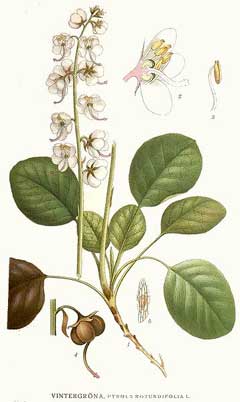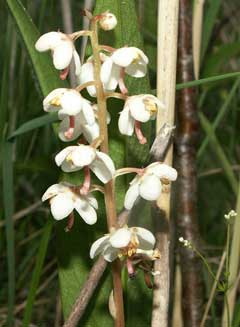 |
|
http://commons.wikimedia.org/wiki/File:152_Pyrola_rotundifolia.jpg |
 |
| http://commons.wikimedia.org/wiki/User:B.gliwa |
Translate this page:
Summary
Physical Characteristics

 Pyrola rotundifolia is an evergreen Perennial growing to 0.3 m (1ft) by 0.3 m (1ft in).
Pyrola rotundifolia is an evergreen Perennial growing to 0.3 m (1ft) by 0.3 m (1ft in).
See above for USDA hardiness. It is hardy to UK zone 4. It is in leaf all year, in flower from June to September. The species is hermaphrodite (has both male and female organs) and is pollinated by Bees, flies. The plant is self-fertile.
Suitable for: light (sandy) and medium (loamy) soils. Suitable pH: mildly acid, neutral and basic (mildly alkaline) soils. It can grow in full shade (deep woodland) semi-shade (light woodland) or no shade. It prefers moist soil.
UK Hardiness Map
US Hardiness Map
Synonyms
Plant Habitats
Woodland Garden Dappled Shade; Shady Edge; not Deep Shade; Ground Cover;
Edible Uses
References More on Edible Uses
Medicinal Uses
Plants For A Future can not take any responsibility for any adverse effects from the use of plants. Always seek advice from a professional before using a plant medicinally.
Antirheumatic Antiseptic Antispasmodic Astringent Cardiotonic Contraceptive Diuretic Epilepsy
Ophthalmic Skin Tonic Urinary
The leaves are antirheumatic, antiseptic, antispasmodic, astringent, cardiotonic, contraceptive, diuretic, poultice, sedative and tonic[4, 9, 46, 172, 176, 218, 222]. A decoction is used in the treatment of skin diseases, as a gargle and a wash for the eyes[4]. It is used internally in the treatment of epilepsy and other nervous afflictions[4]. The leaves are harvested in mid to late summer and can be used fresh or dried[9]. The plant contains arbutin, a proven diuretic and antibacterial agent that is used as a urinary antiseptic, this hydrolyzes in the body into the toxic hydroquinone[222].
References More on Medicinal Uses
The Bookshop: Edible Plant Books
Our Latest books on Perennial Plants For Food Forests and Permaculture Gardens in paperback or digital formats.

Edible Tropical Plants
Food Forest Plants for Hotter Conditions: 250+ Plants For Tropical Food Forests & Permaculture Gardens.
More

Edible Temperate Plants
Plants for Your Food Forest: 500 Plants for Temperate Food Forests & Permaculture Gardens.
More

More Books
PFAF have eight books available in paperback and digital formats. Browse the shop for more information.
Shop Now
Other Uses
Plants can be used as a ground cover when spaced about 30cm apart each way[208]. They are somewhat slow to settle down though, and only form a good cover when they are growing luxuriantly[208].
Special Uses
Ground cover Scented Plants
References More on Other Uses
Cultivation details
Prefers a moist sandy woodland soil[111, 200] in a cool position with partial shade[1, 11, 200]. Requires a peaty or leafy but not very acid soil that remains moist in the summer[31, 187]. Plants are hardy to at least -20°c[187]. This is a very ornamental[1] but difficult plant to grow. It requires a mycorrhizal relationship in the soil and therefore needs to be grown initially in soil collected from around an established plant[200]. It is also very difficult from seed as well as being intolerant of root disturbance which makes division difficult[1]. The flowers have a delicious almond-like fragrance[245].
References Carbon Farming Information and Carbon Sequestration Information
Temperature Converter
Type a value in the Celsius field to convert the value to Fahrenheit:
Fahrenheit:
The PFAF Bookshop
Plants For A Future have a number of books available in paperback and digital form. Book titles include Edible Plants, Edible Perennials, Edible Trees,Edible Shrubs, Woodland Gardening, and Temperate Food Forest Plants. Our new book is Food Forest Plants For Hotter Conditions (Tropical and Sub-Tropical).
Shop Now
Plant Propagation
Seed - the only information we have on this species is that it is difficult from seed and germinates infrequently[200]. We would suggest sowing the seed as soon as it is ripe if this is possible. Sow it into soil collected from around an established plant, only just covering the seed, and put the pot in a shady part of a cold frame. Pot up any young seedlings as soon as they are large enough to handle, once again using soil from around an established plant. Plant out into their permanent positions when the plants are large enough. You should not need to use soil from around an established plant to do this since the soil in the pot will contain the necessary micorrhiza. Division with great care in the spring[1, 111]. Pot up the divisions using some soil from around an established plant, grow on in a lightly shaded part of a greenhouse or frame and do not plant out until the plants are growing away vigorously[200].
Other Names
If available other names are mentioned here
Native Range
TEMPERATE ASIA: Afghanistan, Russian Federation-Ciscaucasia (Ciscaucasia), Georgia, Russian Federation (Dagestan), Russian Federation-Western Siberia (Western Siberia), Russian Federation-Eastern Siberia (Eastern Siberia), Kazakhstan, Kyrgyzstan, Tajikistan, Mongolia, China (Xinjiang Uygur Zizhiqu) EUROPE: Denmark, Finland, United Kingdom, Norway, Sweden, Czechoslovakia, Austria, Belgium, Switzerland, Germany, Hungary, Netherlands, Poland, Russian Federation (European part), Belarus, Estonia, Lithuania, Latvia, Ukraine, Former Yugoslavia, Bulgaria, Italy, Romania, Spain, France
Weed Potential
Right plant wrong place. We are currently updating this section.
Please note that a plant may be invasive in one area but may not in your area so it's worth checking.
Conservation Status
IUCN Red List of Threatened Plants Status :

Growth: S = slow M = medium F = fast. Soil: L = light (sandy) M = medium H = heavy (clay). pH: A = acid N = neutral B = basic (alkaline). Shade: F = full shade S = semi-shade N = no shade. Moisture: D = dry M = Moist We = wet Wa = water.
Now available:
Food Forest Plants for Mediterranean Conditions
350+ Perennial Plants For Mediterranean and Drier Food Forests and Permaculture Gardens.
[Paperback and eBook]
This is the third in Plants For A Future's series of plant guides for food forests tailored to
specific climate zones. Following volumes on temperate and tropical ecosystems, this book focuses
on species suited to Mediterranean conditions—regions with hot, dry summers and cool, wet winters,
often facing the added challenge of climate change.
Read More
Expert comment
Author
L.
Botanical References
17200
Links / References
For a list of references used on this page please go here
Readers comment
© 2010, Plants For A Future. Plants For A Future is a charitable company limited by guarantee, registered in England and Wales. Charity No. 1057719, Company No. 3204567.